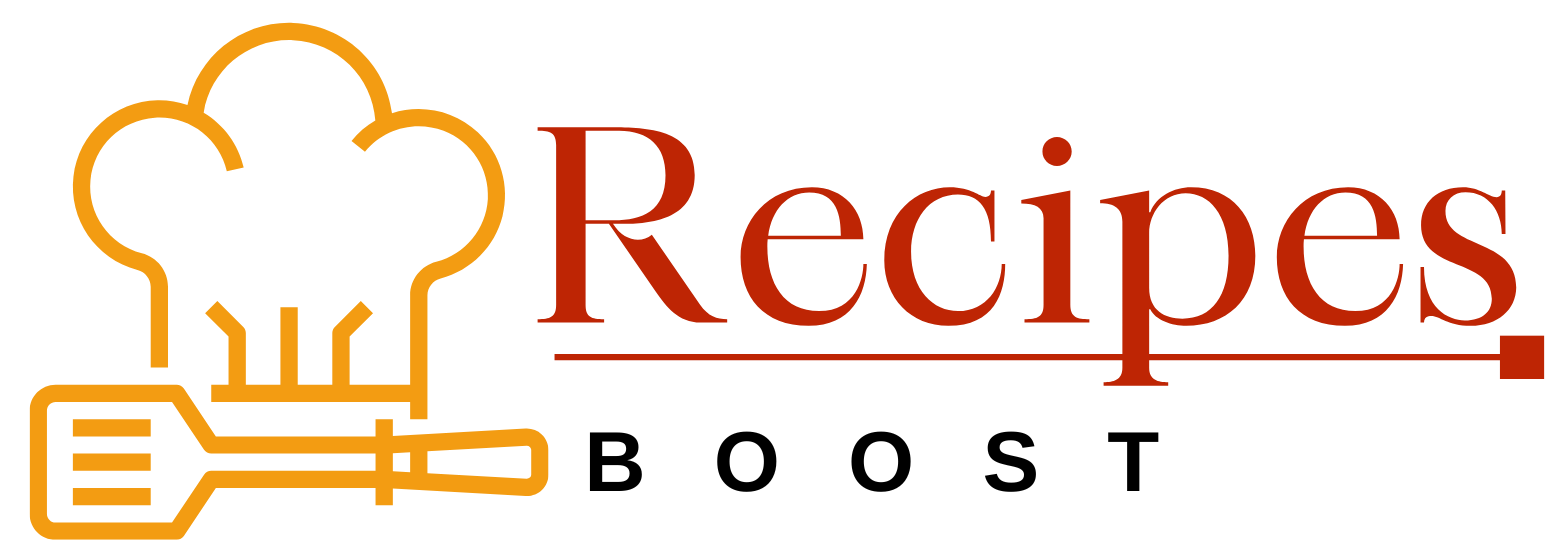Smoked Meatloaf Recipe so Good it should be Illegal
Smoked Meatloaf Recipe
Table of Contents
Introduction
Slices of smoked meatloaf served with mashed potatoes, showcasing the juicy interior and rich glaze. This smoked meatloaf recipe takes a beloved comfort food classic and gives it a mouthwatering barbecue twist. Imagine a tender, juicy meatloaf infused with wood-fired flavor, cooked low and slow until it’s perfectly smoky and moist. If you love traditional meatloaf but also enjoy firing up the smoker, then this smoked meatloaf recipe is going to be your new favorite. In this article, I’ll guide you through every step of making the perfect smoked meatloaf – from understanding what it is, to preparing the ingredients, smoking it to perfection, and even how to serve it up in style. By the end, you’ll have all the confidence and know-how to impress your family or guests with a sensational smoked meatloaf recipe that tastes like it came from a gourmet barbecue joint.
What Is Smoked Meatloaf?
Smoked meatloaf is exactly what it sounds like: a classic meatloaf that’s cooked in a smoker instead of a regular oven. By smoking the meatloaf (as done in a smoked meatloaf recipe), we allow it to slowly cook in a bath of aromatic wood smoke, which imparts a deep, rich flavor to the meat. The result is a delightful fusion of traditional homestyle cooking and smoky barbecue goodness. Unlike an oven-baked meatloaf, a smoked meatloaf typically cooks at a lower temperature (around 225–250°F or 107–120°C) for several hours. This low-and-slow method not only infuses flavor but also helps keep the meatloaf incredibly moist. The exterior develops a slight “bark” – a flavorful, caramelized crust often enhanced by a spiced rub or glaze – while the inside stays tender and juicy. In other words, a smoked meatloaf is the ultimate upgrade to your usual meatloaf, combining the comfort of a family recipe with the complex flavors of outdoor cooking. Whether you’re a BBQ enthusiast or just curious, trying a smoked meatloaf recipe will show you how smoking can elevate a simple dish into something extraordinary.

Ingredients Overview
Before we dive into the smoked meatloaf recipe steps, let’s go over the ingredients you’ll need. This smoked meatloaf recipe uses simple, wholesome ingredients common in many kitchens, with a couple of special touches to boost flavor. Here’s what you’ll need to make a 2-pound smoked meatloaf (about 900 g), along with why each ingredient is important:
- Ground Beef – 2 lb (about 900 g): The star of the show. We recommend an 80/20 or 85/15 ground beef (i.e., about 15–20% fat). This bit of fat ensures the meatloaf stays juicy during the long smoke. Too lean and it could dry out; too fatty and it might get greasy. A blend in this range is just right for a moist, flavorful loaf.
- Olive Oil – 1 tablespoon (15 ml): Used for sautéing the onions. This will help soften the onion as it cooks.
- Onion – ½ medium, finely diced (about 1 cup or 150 g): Onions add moisture, sweetness, and depth of flavor to the meatloaf. Cooking the onion first mellows its sharpness, and fine dicing helps it blend into the meatloaf without leaving any raw crunch.
- Bread Crumbs – ¾ cup (about 75 g): Acts as a binder and filler, giving the meatloaf structure and a tender texture. Mixing breadcrumbs with milk creates a moist paste (panade) that keeps the meatloaf tender. Any type of breadcrumb works here, including panko (Japanese bread crumbs).
- Tomato Paste – 2 tablespoons (about 30 g), divided: This concentrated tomato flavor is used both inside the meatloaf and in the glaze on top. We’ll mix about 1 tablespoon into the meat mixture for richness and a hint of tang, and reserve the other tablespoon for the glaze.
- Milk – 1 cup (240 ml): Combined with the breadcrumbs to form the panade. The milk hydrates the breadcrumbs, which then help lock in moisture. Whole milk works great, but any milk will do. This is one secret to a juicy meatloaf.
- Garlic Powder – 2 teaspoons (about 6 g): Brings a savory garlicky note that’s evenly distributed throughout the meat. Garlic powder distributes evenly, ensuring every bite has a delicious garlic flavor.
- Worcestershire Sauce – 1 tablespoon (15 ml): A classic meatloaf ingredient for good reason. This fermented sauce adds a punch of umami, a touch of tang and sweetness, and depth that complements the beef. It provides that extra depth that people love but can’t always pinpoint.
- Eggs – 2 large, beaten: Eggs act as a binder, holding the meatloaf together so it slices nicely without falling apart. They also add a bit of moisture and richness. Lightly beat them before mixing in, so they incorporate more easily into the meat mixture.
- Paprika – 1 teaspoon (about 2 g): Adds a mild warmth and helps give the meatloaf a beautiful color. You can use regular paprika or smoked paprika for extra smoky flavor. It’s a key spice that, along with garlic and parsley, seasons the meatloaf from the inside.
- Kosher Salt – 2 teaspoons (about 10 g): Enhances all the flavors. We use kosher salt here; if you only have table salt, use a bit less since it’s finer. Keep in mind the BBQ sauce and rub also have salt, so we don’t overdo it in the mix.
- Parsley (Dried or Fresh) – 2 teaspoons: Adds a touch of freshness and color. You can use dried or fresh parsley here (fresh will require a bit more). It’s mostly for flavor balance and visual appeal (little green flecks in the loaf).
- BBQ Sauce – ½ cup (120 ml): Forms the base of our glaze. A good barbecue sauce provides sweetness, tang, and smokiness to coat the meatloaf. Use your favorite brand or homemade sauce – whatever you love will work. This smoked meatloaf recipe gets brushed with the BBQ-tomato glaze multiple times during cooking, creating a sticky, caramelized exterior.
- Apple Cider Vinegar – 1 tablespoon (15 ml): A bit of vinegar brightens up the glaze by adding acidity and balancing the sweetness. Apple cider vinegar is mild and fruity, perfect for a barbecue glaze (white vinegar works in a pinch too).
- Hardcore Carnivore Red Seasoning – 1–2 tablespoons: This is a bold Texas-style BBQ rub known for giving meat a deep red color and savory flavor. We sprinkle it on top of the shaped meatloaf before smoking to form a flavorful “bark.” If you don’t have this particular seasoning, you can substitute your favorite barbecue dry rub, or simply use a mix of paprika, black pepper, and a bit of chili powder. It’s an optional ingredient, but it really makes this smoked meatloaf recipe look and taste like true BBQ.
With these ingredients on hand, you’re ready to get started. Now, let’s walk through how to prepare and smoke your meatloaf step by step.
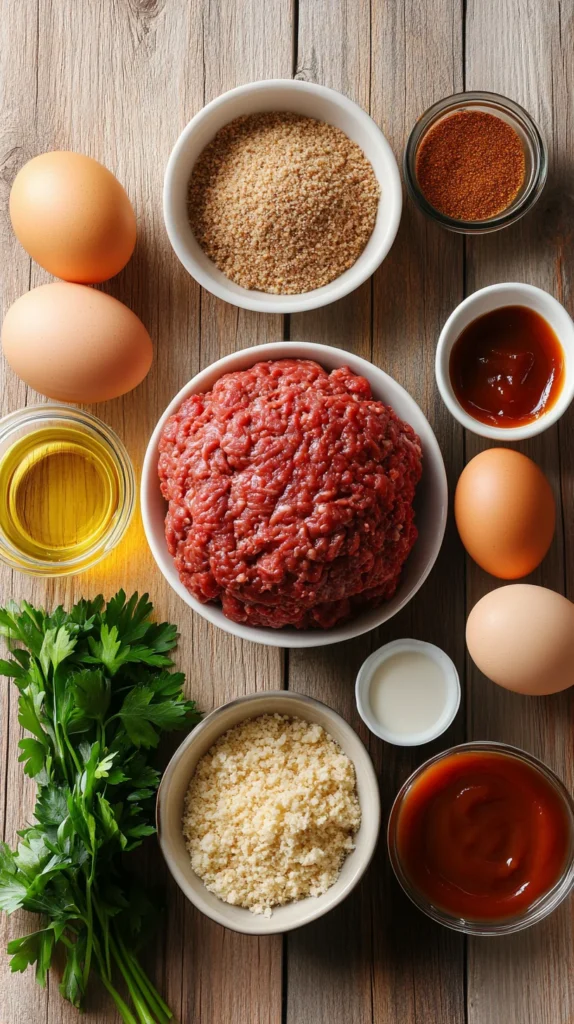
Step-by-Step Preparation Guide
Making a smoked meatloaf might sound involved, but it’s actually straightforward. Set aside a bit of time for prep and a few hours for smoking, and you’ll be rewarded with an incredible meal. Follow this smoked meatloaf recipe guide, and you’ll master it on your first try. Let’s get started:
- Preheat Your Smoker: Preheat your smoker (or pellet grill) to 250°F (about 120°C). This moderate temperature will smoke the meatloaf gently, allowing it to cook through without drying out. Make sure you have your preferred wood chips or pellets ready for smoking (hickory, apple, oak, or mesquite all pair well with beef). While the smoker heats up, you can start on the prep.
- Sauté the Onions: In a small pan, heat the olive oil over medium heat. Add the finely diced onion and cook, stirring occasionally, until the onion is softened and translucent. This usually takes about 7–10 minutes. You don’t need to brown them; just cook until they’re sweet and tender. Once done, remove from heat and let the onions cool completely before adding them to the meat mixture. Hot onions could start cooking the beef or eggs when mixing, so be sure they’re cooled first.
- Prepare the Panade (Bread Crumb Mixture): In a bowl, combine the ¾ cup of breadcrumbs and 1 cup of milk. Stir them together to form a thick paste and let it sit for about 5 minutes. The breadcrumbs will soak up the milk and become very soft. This panade is a key to a moist meatloaf – it will release moisture slowly into the meat as it cooks, preventing the meatloaf from drying out.
- Mix the Meatloaf Ingredients: In a large mixing bowl, add the ground beef, cooled sautéed onions, the breadcrumb-milk panade, beaten eggs, garlic powder, paprika, Worcestershire sauce, 1 tablespoon of the tomato paste (remember, we divided it), kosher salt, and parsley. Now, gently mix everything together with clean hands or a spoon. Be careful not to overwork the meat – mix just until all the ingredients are evenly distributed. Over-mixing can make the meatloaf tough. You want a uniform mixture where the panade and seasonings are well incorporated with the meat.
- Shape the Loaf: Take the mixed meatloaf mixture and shape it into a loaf form. The beauty of a smoked meatloaf is that we’re not using a loaf pan (as you might in the oven); instead, shape a free-form loaf with your hands. Place it on a wire rack or a grill-safe baking rack. (You can line the rack with foil underneath for easy cleanup or put a foil pan under the rack to catch drippings in the smoker.) Aim for an even thickness so it cooks uniformly. Once shaped, sprinkle the entire outside of the loaf with the Hardcore Carnivore Red seasoning (or your chosen BBQ rub). Pat it lightly onto the surface so it sticks. This will create a flavorful crust on our smoked meatloaf.
- Mix the Glaze: In a small bowl, mix together the remaining 1 tablespoon of tomato paste, the ½ cup BBQ sauce, and the 1 tablespoon of cider vinegar. This creates a tangy, rich glaze. Set this aside – you’ll be brushing it onto the meatloaf during smoking to build up that delicious sticky exterior.
- Smoke the Meatloaf: Once your smoker is up to 250°F and producing good smoke, place the wire rack with the meatloaf into the smoker. Close the lid and let the smoked meatloaf cook. It will take roughly 3 to 4 hours to fully cook through, depending on the thickness of your loaf and how consistent your smoker’s temperature is. Resist the temptation to crank up the heat – low and slow is what gives us that smoky flavor and tender result.
- Glaze During Cooking: After about 35–40 minutes of smoking, open the smoker and brush a generous layer of the prepared BBQ-tomato glaze over the top and sides of the meatloaf. Close the lid and continue cooking. Repeat this glazing step every 35–40 minutes. Brushing periodically adds flavor and moisture, gradually building up a sticky, caramelized barbecue crust on the meatloaf.
- Cook to Temperature, Not Just Time: You’re looking for an internal temperature of 165°F (74°C) in the center of the meatloaf to know it’s done. Use a meat thermometer inserted into the thickest part of the loaf to check. Smoking for 3–4 hours at 250°F usually does it, but always trust your thermometer over the clock. Once the smoked meatloaf reaches 160–165°F, you can pull it from the smoker. (Ground meat needs to reach 165°F for safety; 160°F then a rest will usually climb to 165°F.) It’s better to check a bit early than to discover you’ve overshot it by an hour – especially for a smoked meatloaf recipe like this.
- Rest the Meatloaf: Carefully remove the meatloaf from the smoker and place it on a cutting board or platter. Brush on one last coating of the glaze for good measure. Let the smoked meatloaf rest for about 5–10 minutes before slicing. Resting is crucial – it allows the juices inside to redistribute and settle, so they won’t all rush out when you cut into the meatloaf. This means each slice will be moist and flavorful. (Your patience will be rewarded with a juicier result!)…..For an alternative take on smoked meatloaf with a classic BBQ twist, you can check out this smoked meatloaf recipe from Food Network. It offers a slightly different blend of ingredients and techniques worth trying.
- Slice and Serve: Using a sharp knife, slice your meatloaf into thick slices (about ¾ to 1 inch thick is nice). You’ll see the lovely smoke ring around the edges (a reddish-pink hue that’s the hallmark of smoked meats) and the juicy interior. Get ready to enjoy the fruits of your labor!
That’s it – you’ve just made a phenomenal smoked meatloaf. In the next sections, we’ll explore some fun variations, serving ideas, and tips to make this smoked meatloaf recipe truly your own.
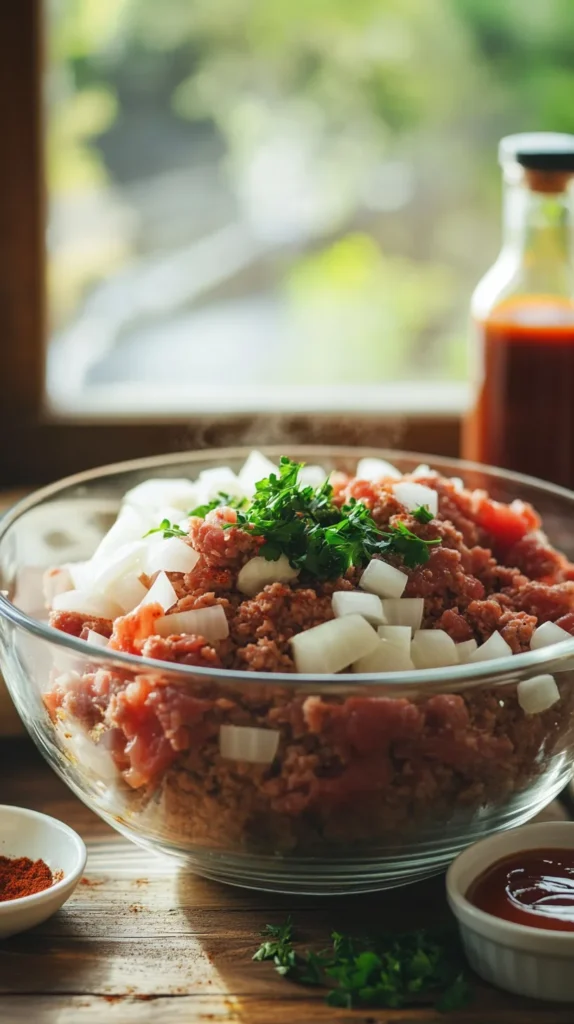
Variations to Try
One of the great things about any smoked meatloaf recipe is how adaptable it can be. Once you have the basic method down, you can get creative and tailor the meatloaf to your taste or dietary needs. Here are some variations and twists you might consider trying:
- Meat Mix-Up: While this recipe uses all beef, you can experiment in your smoked meatloaf recipe by using a mix of meats. A popular approach is half ground beef and half ground pork – the pork can add extra juiciness and flavor. Some people even mix in a bit of ground Italian sausage or ground veal for complexity. For a bold Southern spin, you might also want to try this Texas-style smoked meatloaf recipe from Allrecipes, which combines jalapeños and BBQ sauce for big flavor.. If you prefer a lighter option, ground turkey or chicken can work too (though they’re leaner, so consider adding a bit of olive oil or even a strip of bacon on top to keep it moist).
- Bacon-Wrapped Smoked Meatloaf: If you love bacon (who doesn’t?), try wrapping your meatloaf in bacon before smoking. After you shape the loaf, drape a few strips of thin-cut bacon over the top and sides, tucking them underneath if possible. The bacon will baste the meat as it renders and create a smoky, crispy exterior. Bacon-wrapping really takes this smoked meatloaf recipe to the next level of flavor. Just watch that the bacon doesn’t over-crisp; you might want to raise the smoker temperature to 275°F (135°C) for the last half hour to render it nicely.
- Cheese-Stuffed Meatloaf: For a fun surprise, create a cheese-filled smoked meatloaf. Take your meat mixture and fill it with cheese before shaping the final loaf. For example, you can form two thin loaves, lay slices of cheddar or pepper jack cheese in the middle, then put the loaves together and seal the edges to encase the cheese. When you slice the finished meatloaf, melty cheese will ooze out – a delight for cheese lovers. Smoked meatloaf with a molten cheesy center is indulgent and memorable. This twist will surely make your smoked meatloaf recipe stand out from the rest.
- Spice and Heat Variations: The seasoning in this smoked meatloaf recipe is fairly classic, but you can dial it up or change it out to suit your heat preference. Want a spicy kick? Add some chili powder or cayenne pepper to the mix, or use a spicy BBQ sauce in the glaze. Fancy a more herbal profile? Try Italian seasoning instead of just parsley, or throw in some oregano and basil for an Italian-American vibe. You could also mix in a teaspoon of cumin and a pinch of cilantro for a hint of Tex-Mex flavor. The key is that the base smoked meatloaf recipe is a blank canvas for your favorite flavors.
- Glaze Alternatives: While our smoked meatloaf recipe uses a BBQ sauce and tomato paste glaze, you can try other glaze ideas too. A traditional ketchup and brown sugar glaze (with a touch of mustard) brushed on near the end of cooking will give a sweet, tangy crust reminiscent of classic diner meatloaf. For a spicy-sweet twist, mix apricot jam with a bit of hot sauce or sriracha and use that as a glaze. Feel free to get creative with your glaze – as long as it has some sugar, it will caramelize nicely in the smoker.
These variations are just a starting point. Feel free to mix and match ideas – for instance, you could do a half beef/half pork meatloaf that’s cheese-stuffed and wrapped in bacon for the ultimate decadent version! As long as you follow the basic technique of this smoked meatloaf recipe (using a binder, cooking to temperature, etc.), you can experiment with flavors to find your personal favorite smoked meatloaf creation.
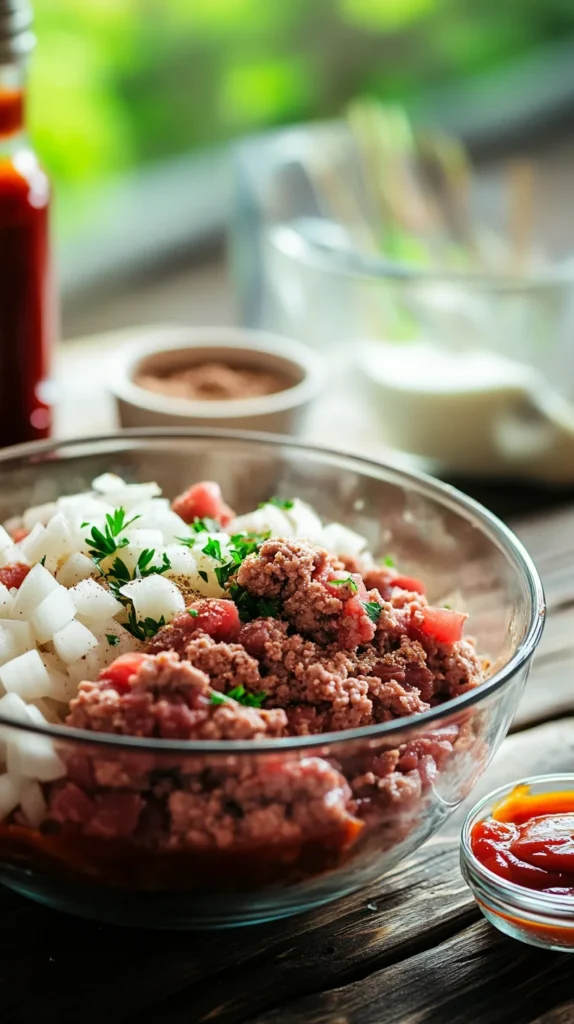
Serving Suggestions
After all that effort on this smoked meatloaf recipe, you’ll want to pair it with sides and garnishes that complement its smoky, savory flavor. Here are some serving suggestions to make your smoked meatloaf recipe dinner truly shine:
- Classic Sides: You can’t go wrong with traditional comfort food sides. Creamy mashed potatoes or scalloped potatoes are a natural pairing with meatloaf, allowing you to spoon extra glaze or juices over the top. Macaroni and cheese (maybe even a smoked mac and cheese) is another indulgent side that matches the rich heartiness of smoked meatloaf. For something green, consider buttered green beans, roasted Brussels sprouts, or a simple side salad to balance the richness.
- Barbecue Flair: Since this meatloaf carries a barbecue vibe, serve it with BBQ-style sides. Baked beans with a touch of brown sugar and bacon would resonate with the smoky-sweet notes of the meatloaf. Creamy coleslaw (either classic mayo-based or a tangy vinegar slaw) adds crunch and a refreshing contrast. Some corn on the cob or grilled corn salad could also provide a nice sweet crunch alongside the meat.
- Sauces and Extras: The meatloaf will have its own glaze, but extra sauce on the side is always welcome. Warm up some additional BBQ sauce for drizzling or dipping each bite. If you like a little heat, a spicy chipotle mayo or sriracha ketchup can be served alongside for those who want to kick it up. Chopped fresh parsley or chives sprinkled over the sliced meatloaf adds a pop of color and a hint of freshness. You could even crumble a little crispy bacon on top of the slices if you went the bacon-wrapped route.
- Bread or Rolls: Consider serving slices of your smoked meatloaf with a side of crusty bread or dinner rolls. Folks often enjoy making a little sandwich or simply using bread to mop up any delicious juices or extra sauce on the plate. (Leftover smoked meatloaf also makes fantastic sandwiches the next day – thick slices on toasted bread with a smear of mayo or extra BBQ sauce, maybe a pickle or onion slice!)
- Beverage Pairings: For drinks, you can’t go wrong with a tall glass of iced tea or lemonade to keep things classic, refreshing, and family-friendly.
When plating your smoked meatloaf, arrange it proudly as the centerpiece of the plate. Two slices per person is a good starting portion (it is hearty!), and then add your chosen sides. Don’t forget to drizzle a little extra warm glaze or BBQ sauce on the slices for shine and flavor. With the right accompaniments, this smoked meatloaf recipe turns into a memorable feast that brings together the best of backyard barbecue and homey kitchen cooking.
Tips and Tricks for the Perfect Smoked Meatloaf
Brushing a thick BBQ glaze onto the meatloaf as it smokes helps build up layers of flavor on the crust. Even with a detailed smoked meatloaf recipe, a few extra pointers can make the difference between a good meatloaf and a truly outstanding one. Based on experience and common pitfalls, here are some tips and tricks to ensure your smoked meatloaf turns out perfect every time:
- Don’t Skip the Panade: The milk-and-breadcrumb paste (panade) might seem like an extra step in a smoked meatloaf recipe, but it’s a game-changer. It’s the secret weapon for a tender, juicy meatloaf. The starches in the bread absorb liquid and then release it slowly during cooking, which keeps the meat from drying out. If you ever tried a meatloaf that was crumbly or dry, it likely lacked a proper panade or enough binding.
- Use a Thermometer: Smoking is not an exact science, and cooking times can vary. Always use an instant-read meat thermometer to check for that 165°F (74°C) internal temperature when following this smoked meatloaf recipe. This ensures the meatloaf is safely cooked through (especially important with ground meat and eggs in the mix), but not overcooked. Overcooking much beyond 165°F can start drying it out even with all the moisture techniques we use. Trust the temp, not just the clock.
- Avoid Over-mixing: When combining your meatloaf mixture, mix it just enough to bring everything together. Over-mixing develops the proteins too much and can make the cooked loaf dense and tight (a bit like a sausage, which we don’t want here). A light touch means a tender bite. If you’re unsure, when making this smoked meatloaf recipe, stop mixing as soon as the ingredients look evenly dispersed.
- Shape Matters: Try to shape your meatloaf with an even thickness throughout. If one end is much thicker than the other, it won’t cook at the same rate – the thinner end might dry out by the time the thick end is done. A uniform loaf shape ensures consistent cooking in this smoked meatloaf recipe. Also, pat it firm enough to hold together, but you don’t need to compress it super hard (we want to keep it tender).
- Keep the Smoker Closed: It’s tempting to check on your creation frequently, but every time you open the smoker, heat and smoke escape. Apart from the scheduled glazing intervals, try to keep that lid closed for this smoked meatloaf recipe. Patience will reward you with a better, more evenly smoked meatloaf, as temperature fluctuations are minimized.
- Wood Choice: The type of wood you use for smoking will subtly affect the flavor. For this smoked meatloaf recipe, the type of wood you choose will depend on your taste. Strong woods like hickory or mesquite give a pronounced smoke flavor that goes well with beefy meatloaf. Fruit woods like apple or cherry offer a milder, slightly sweet smoke. If you’re new to smoking, a mix of hickory and a fruit wood is a nice balanced choice. Just ensure your wood chips or pellets are meant for cooking (never use treated wood or softwoods that can create bitter smoke)…Looking for a creative twist? Serious Eats offers a method using a wood plank on the grill to infuse even more smoky aroma and keep the meatloaf extra juicy.
- Resting is Essential: As mentioned in the steps, resting the meatloaf after smoking is crucial. During cooking, the juices in the meatloaf are bubbling and moving around. If you cut in immediately, those juices will pour out and you’ll end up with a drier slice. A good 5–10 minute rest lets everything settle so that when you slice it, each piece remains nice and juicy. Always remember, even the best smoked meatloaf needs that resting time to retain its juices.
- Make Ahead Option: With this smoked meatloaf recipe, you can prepare the meatloaf mixture a day in advance if needed. Mix all the ingredients and shape the loaf, then cover it tightly with plastic wrap and refrigerate overnight. This can actually help the flavors meld (like an overnight marinade). When you’re ready to cook, let it sit at room temperature for 30 minutes while you heat the smoker, then proceed as usual. (Note: A very cold meatloaf may take a bit longer to cook, so using that thermometer is extra important.)
- (Optional) Freeze for Later: You can also freeze an uncooked meatloaf (without the glaze) if you want to prep in advance. Wrap it tightly in plastic wrap and foil, and freeze. Thaw in the refrigerator before smoking. This is handy if you want to make multiple meatloaves or have a ready-to-cook meal down the line.
By keeping these tips in mind, you’ll avoid common issues and be well on your way to smoked meatloaf perfection. It’s often the little details that elevate a recipe, and soon you’ll be so confident that you might even start developing your own signature touches for your smoked meatloaf.
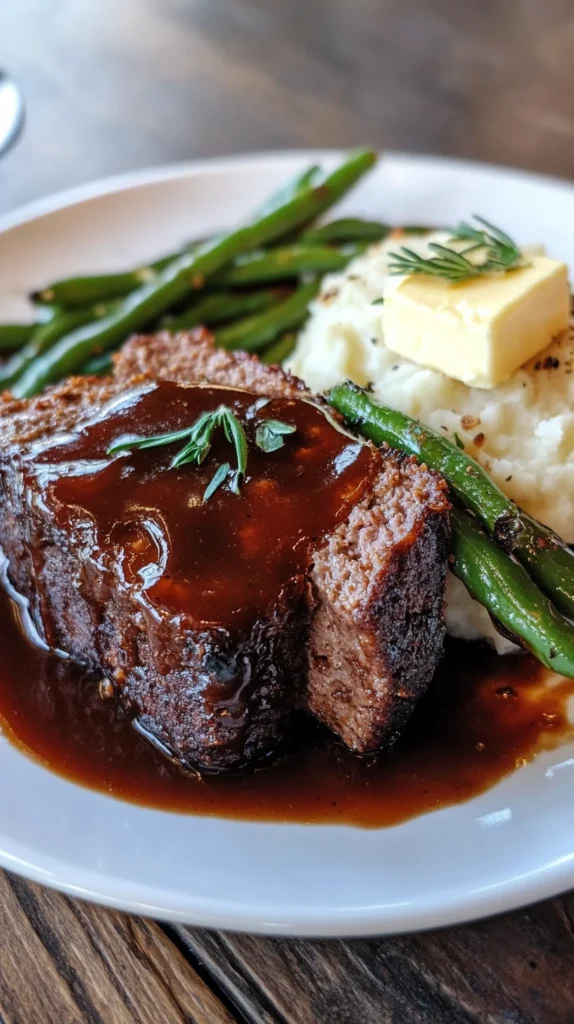
Nutritional Information
Cooking at home isn’t just about great taste – it’s also nice to know what you’re feeding yourself and your family. Below is the approximate nutritional breakdown for this smoked meatloaf recipe. We’re assuming about 8 servings per 2 lb (900 g) meatloaf, with each serving being a hearty slice of the loaf. Keep in mind these values can vary based on the exact ingredients (for example, different BBQ sauce brands or meat fat content) and portion sizes, but this gives a good ballpark:
| Nutrient | Amount Per Serving (approx.) |
| Calories | ~400 kcal |
| Protein | ~27 g |
| Carbohydrates | ~13 g |
| Dietary Fiber | ~1 g |
| Total Fat | ~25 g |
| Saturated Fat | ~9 g |
| Cholesterol | ~120 mg |
| Sodium | ~650 mg |
| Sugar | ~8 g |
Per serving values are estimated for one slice of meatloaf (about 1/8 of the recipe). This smoked meatloaf recipe is a protein-packed dish, relatively low in carbs (especially if you choose a low-sugar BBQ sauce), but it does have a moderate amount of fat from the beef and eggs. Pairing it with vegetables or a salad can round out the meal nutritionally. If you need to adjust for dietary needs, consider the variations mentioned (like using leaner meat or a sugar-free sauce) and note that those will change the nutrition stats accordingly.
Common Mistakes to Avoid
Even a tried-and-true smoked meatloaf recipe can go wrong if a few key steps aren’t followed. Here are some common mistakes people make when smoking a meatloaf, and how to avoid them:
- Using Meat That’s Too Lean: In any smoked meatloaf recipe, a very lean meatloaf (like 95% lean beef or ground chicken breast with no added fat) is prone to drying out, especially in the smoker. If you must use lean meat for dietary reasons, make sure to add some extra fat (like a bit of olive oil or finely chopped bacon in the mix) and be extra diligent with moisture-adding steps (panade, glaze, etc.). Ideally, stick to an 80/20 or 85/15 meat blend for a juicy result.
- Skipping the Pre-cook on Veggies: If you throw raw onions (or other raw vegetables) straight into the meatloaf mix, they might not fully cook or soften by the time the meatloaf is done, leaving you with odd crunchy bits and a harsher flavor. That’s why in this smoked meatloaf recipe we sauté the onions (and any other veggies like bell peppers) beforehand. Taking the time to soften these ingredients ensures they integrate seamlessly into the meatloaf with a sweeter, mellow flavor.
- Overcompacting the Loaf: When shaping the meatloaf, it’s possible to pack it too densely. Pressing it down too hard can make the texture tighter and prevent smoke from penetrating well. You want the loaf to hold together, but still have a bit of looseness in the mix. Think of it like forming a burger patty – firm but not rock-solid. Also, a loaf that’s too thick in one spot may cook unevenly, so shape it uniformly.
- Not Monitoring the Temperature: Relying solely on cooking time is a mistake. Smokers can run hot or cool, weather affects them, and the shape of your meatloaf matters. If you don’t monitor the internal temp, you might undercook (unsafe with ground meat) or overcook (resulting in dry meatloaf). Always cook to 165°F (74°C) internal at the center. Start checking once you’re past the 3-hour mark or if you suspect it’s getting close. It’s better to check a bit early than to discover you’ve overshot it by an hour – especially for a smoked meatloaf recipe like this.
- Neglecting to Rest: We’ve said it before, but it bears repeating – cutting into the meatloaf right away is a common mistake. It’s understandable to be eager (the smell is amazing!), but cutting too soon will let all those lovely juices escape. The result can be noticeably drier. Cover the smoked meatloaf loosely with foil and give it a short rest. Your patience will be rewarded with a juicier slice.
- Forgetting to Glaze (or Glazing Too Early): The glaze is what gives this smoked meatloaf recipe a lot of its character. Some might forget to glaze entirely (missing out on flavor and moisture on the surface), or they brush it on too early and too often. We recommend glazing every 35–40 minutes, starting after the first half hour of cooking. If you put the glaze on right from the start, the sugars in it could darken or burn before the meatloaf is done. So, time your glazing intervals as instructed for the best results in this smoked meatloaf recipe.
By being mindful of these potential missteps, you’ll ensure your smoked meatloaf experience is smooth and rewarding. Remember, even experienced pitmasters learn from a batch that didn’t go as expected – it’s all part of the journey to mastering this smoked meatloaf recipe.
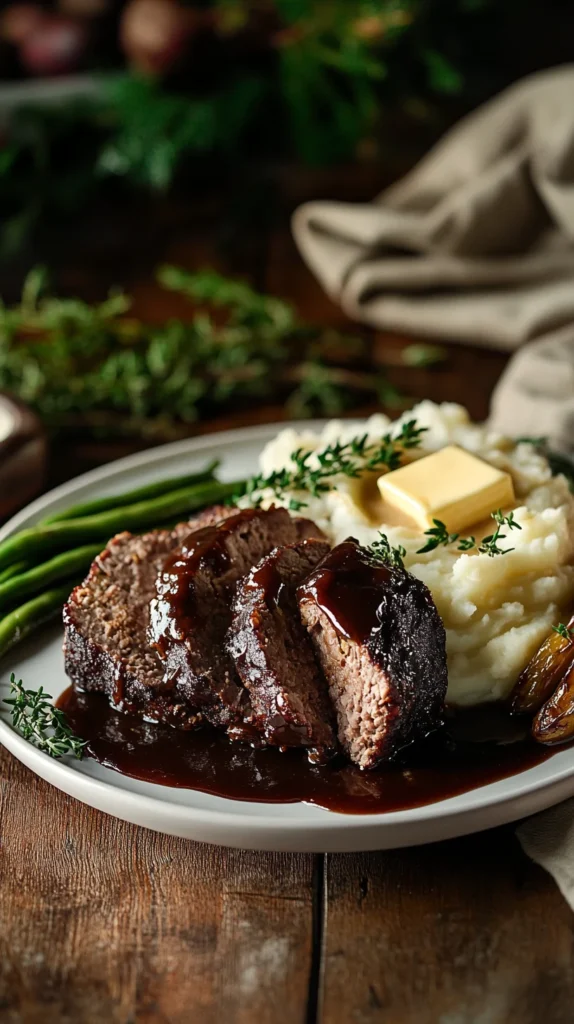
Frequently Asked Questions
Here are answers to some common questions readers have about making this smoked meatloaf recipe:
1. Can I make this smoked meatloaf recipe without a smoker?
Yes, you can still enjoy a “smoked” meatloaf without a dedicated smoker, though you won’t get quite the same depth of smokiness. One option is to use a regular grill (gas or charcoal) set up for indirect cooking with wood chips. For example, on a gas grill you can heat one side to about 250°F and place a foil packet of soaked wood chips or a smoker box over the heat to generate smoke, then cook the meatloaf on the unlit side. On a charcoal grill, bank the coals to one side and add wood chunks to the coals, cooking the meatloaf on the cooler side. Keep the lid closed to trap the smoke. If you only have an oven, you can bake the meatloaf at 250°F (or 275°F to be safe) until done. To impart smokiness without a smoker, try adding a teaspoon of liquid smoke to the meat mixture or use smoked paprika in place of regular paprika. It’s not exactly the same as a true smoked meatloaf recipe, but it can approximate the flavor. Finish the meatloaf under the broiler for a minute or two with the glaze to get a bit of caramelization on top.
2. What’s the best wood for smoking a meatloaf?
There isn’t a single “best” wood – it depends on your taste. For this smoked meatloaf recipe, popular choices include hickory, which gives a strong, hearty smoke flavor that complements beef, or apple wood, which provides a milder, slightly sweet smoke. Cherry wood also pairs nicely and can even give the meat an attractive dark red hue on the outside. Mesquite is a very strong wood that can be great if you love intense smoke, but use it sparingly or blended with milder woods so it doesn’t overpower the meatloaf. If you’re unsure, you could start with a mix (e.g., hickory and apple together) to get a balanced flavor. Experimenting with different wood types is part of the fun of smoking – each will lend a subtle difference to your smoked meatloaf recipe’s final flavor.
3. Can I substitute or add other meats in this smoked meatloaf recipe?
Absolutely. This smoked meatloaf recipe is quite flexible. You can substitute some or all of the beef with other ground meats. Ground pork is commonly mixed with beef to enhance juiciness and flavor. Ground veal could also be added for a traditional meatloaf trio (beef-pork-veal) as found in some classic recipes. If you want to use ground turkey or chicken, you can – just remember they have less fat, so pay attention to our earlier tips about keeping it moist (you might even lay strips of bacon over a turkey meatloaf for added fat and flavor). Even wild game like venison could be used if it’s ground (perhaps combined with a fattier meat like pork). The key is to maintain roughly the same total quantity (around 2 pounds) and to include some fat content for moisture. The smoking process and seasonings will ensure it all comes together deliciously, no matter the meat combo.
4. How do I store and reheat leftover smoked meatloaf?
If you have leftovers, let the meatloaf cool, then store it in the refrigerator within 1–2 hours of cooking (to be food-safe). Wrap the meatloaf tightly in plastic wrap or aluminum foil, or put slices in an airtight container. In the fridge, leftover meatloaf from this smoked meatloaf recipe will keep well for about 3–4 days. To reheat, the best method is to wrap a slice (or the whole leftover portion) in foil and heat in a 300°F (150°C) oven until warmed through. This gentle reheating helps retain moisture. You can sprinkle a tiny bit of water or beef broth in the foil packet to add moisture, and even brush on a little extra BBQ sauce before reheating to refresh the glaze. Alternatively, you can reheat slices in the microwave – do it at a lower power setting and cover the slice with a damp paper towel to prevent drying out. For longer storage, you can freeze smoked meatloaf. Wrap it tightly in plastic wrap and foil (or use a freezer bag). It can last 2–3 months frozen. Thaw overnight in the fridge and then reheat as mentioned. The good news is that smoked meatloaf, just like regular meatloaf, often tastes great the next day – some say even better as the smoky flavors deepen.
5. Why do I need to add milk and breadcrumbs? Can I skip them?
The milk and breadcrumbs (panade) are included in this smoked meatloaf recipe to ensure a tender, moist texture. You might be tempted to skip them to have just pure meat, but you’d be missing out on a key aspect of the texture. The panade isn’t “filler” in a bad way – it’s actually a technique used in many classic meatball and meatloaf recipes to retain moisture. If you leave it out, your meatloaf will still cook, but it may be denser, tougher, or more prone to drying out or crumbling. That said, if you have dietary restrictions (like gluten or lactose intolerance), you can replace these with alternatives rather than omit them entirely. Use a lactose-free milk or even broth instead of milk, and something like oats, crushed gluten-free crackers, or almond flour instead of breadcrumbs. The goal is to have some starch mixed with liquid in the meat. So while you can make a meatloaf without bread and milk, we highly recommend using the panade method in some form for the best result. Your smoked meatloaf will thank you with better flavor and juiciness!
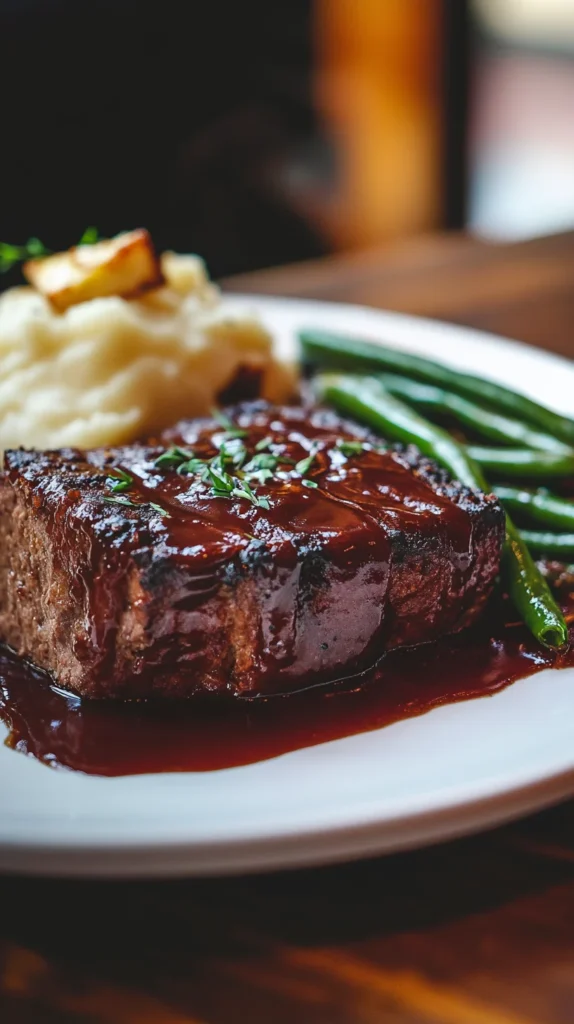
Final Thoughts on the Perfect Smoked Meatloaf
There’s something incredibly satisfying about mastering the perfect smoked meatloaf recipe. It’s the kind of recipe that brings together the comfort of home cooking and the excitement of outdoor barbecue in one delicious package. We took a journey through what a smoked meatloaf is, gathered our ingredients, and followed a step-by-step smoked meatloaf recipe that ensures success. Along the way, we explored variations that cater to every craving, from bacon-wrapped decadence to creative spice twists, and we talked about the best ways to serve this dish to make it a memorable meal.
By now, you should feel ready to fire up your smoker and give this smoked meatloaf recipe a try. Remember that every smoker (and cook) is a little different, so don’t be afraid to make this recipe your own. Maybe you’ll discover a new favorite wood smoke combination, or perhaps you’ll add a personal secret ingredient to the mix. Cooking is all about personal touch. One thing is for sure: when you slice into your first homemade smoked meatloaf from this recipe and take that initial bite of juicy, smoky, flavorful goodness, you’ll know the effort was worth it.
I hope this guide has answered your questions and inspired you to try making smoked meatloaf. It’s a dish that impresses with its rustic elegance – slightly fancy yet totally comforting at the same time. Whether you’re a seasoned pitmaster or a home cook looking to expand your repertoire, this smoked meatloaf recipe is a fantastic way to bring new life to a classic. Happy smoking, and enjoy every savory bite of that perfect smoked meatloaf you’ve created!
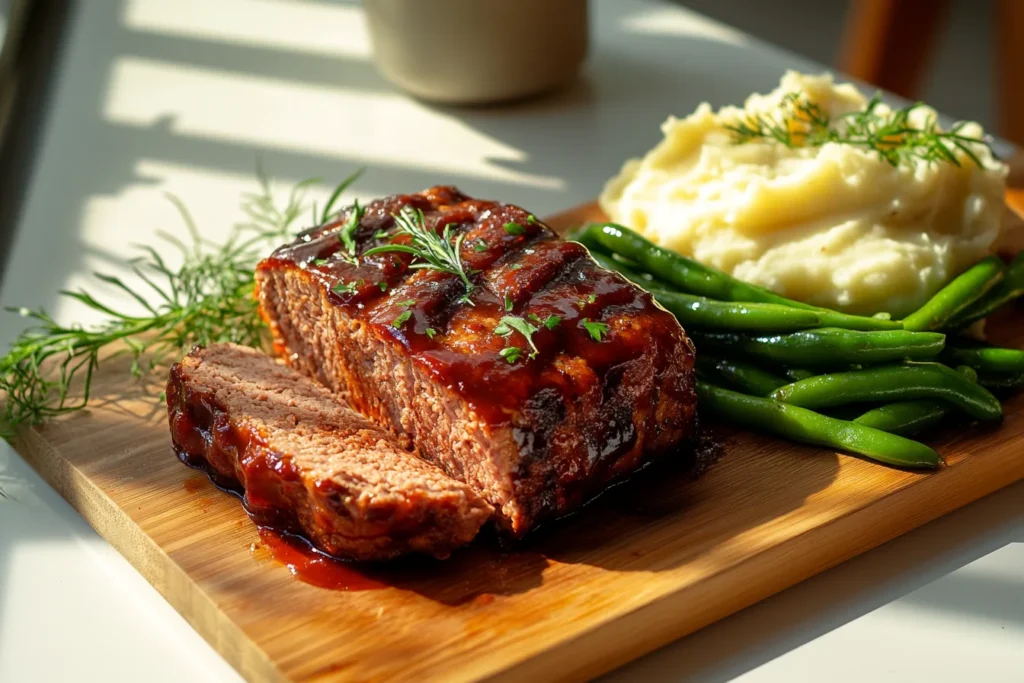
Love rich, satisfying meals that bring everyone to the table? After this smoked meatloaf recipe, you’ll definitely want to try our Better Than Takeout Hibachi Steak With Fried Rice for that hot-off-the-grill vibe, or dive into the heartwarming flavors of our Slow Cooker Ground Beef Stew — perfect for family nights in.
